Piero itinerary
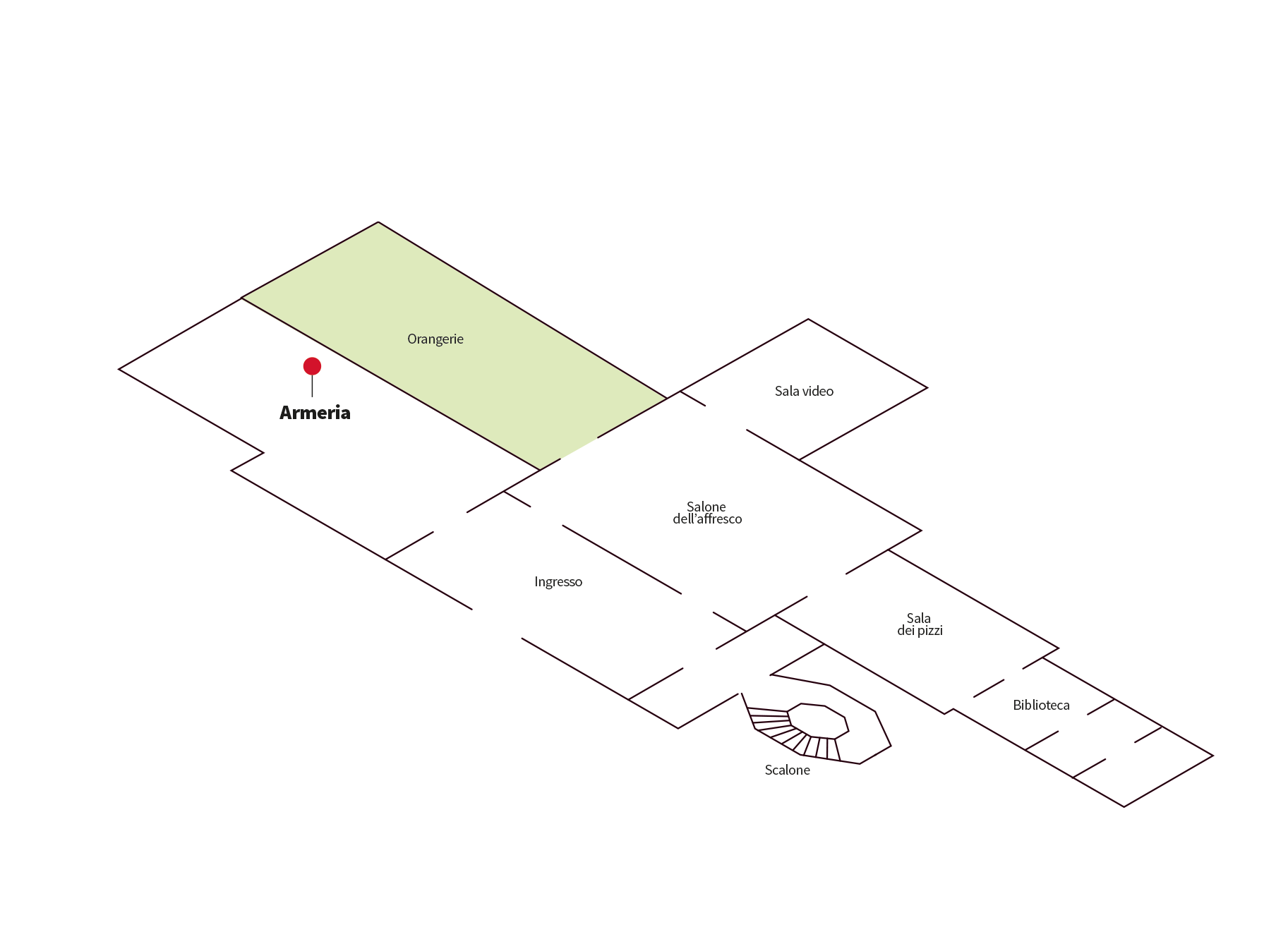
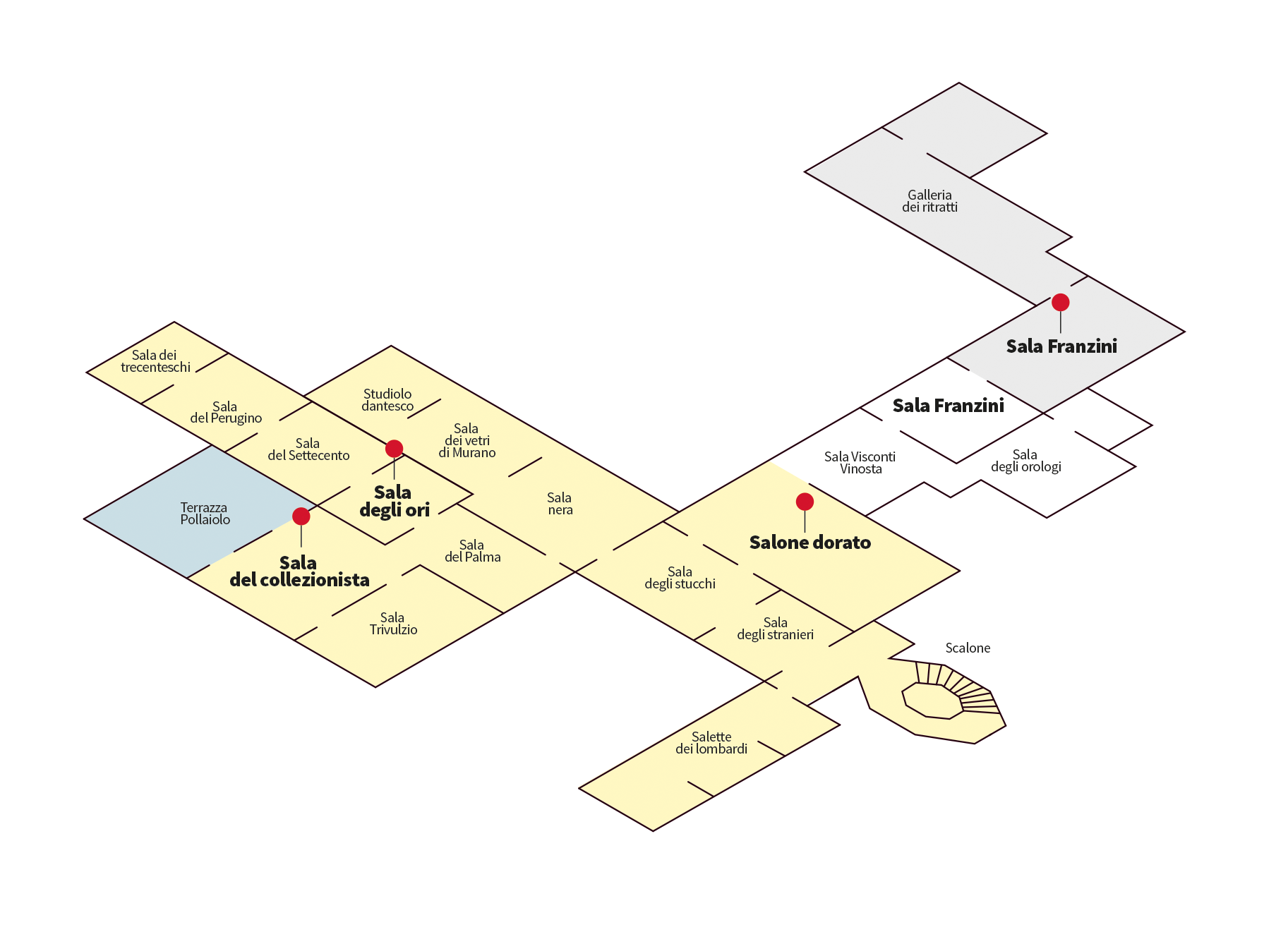
1.
Oriental Style Helmet (inv. 2517)
Nuremberg, c. 1550–70
Steel: engraved, bronzed, and gilded
Armory, vetrina 3
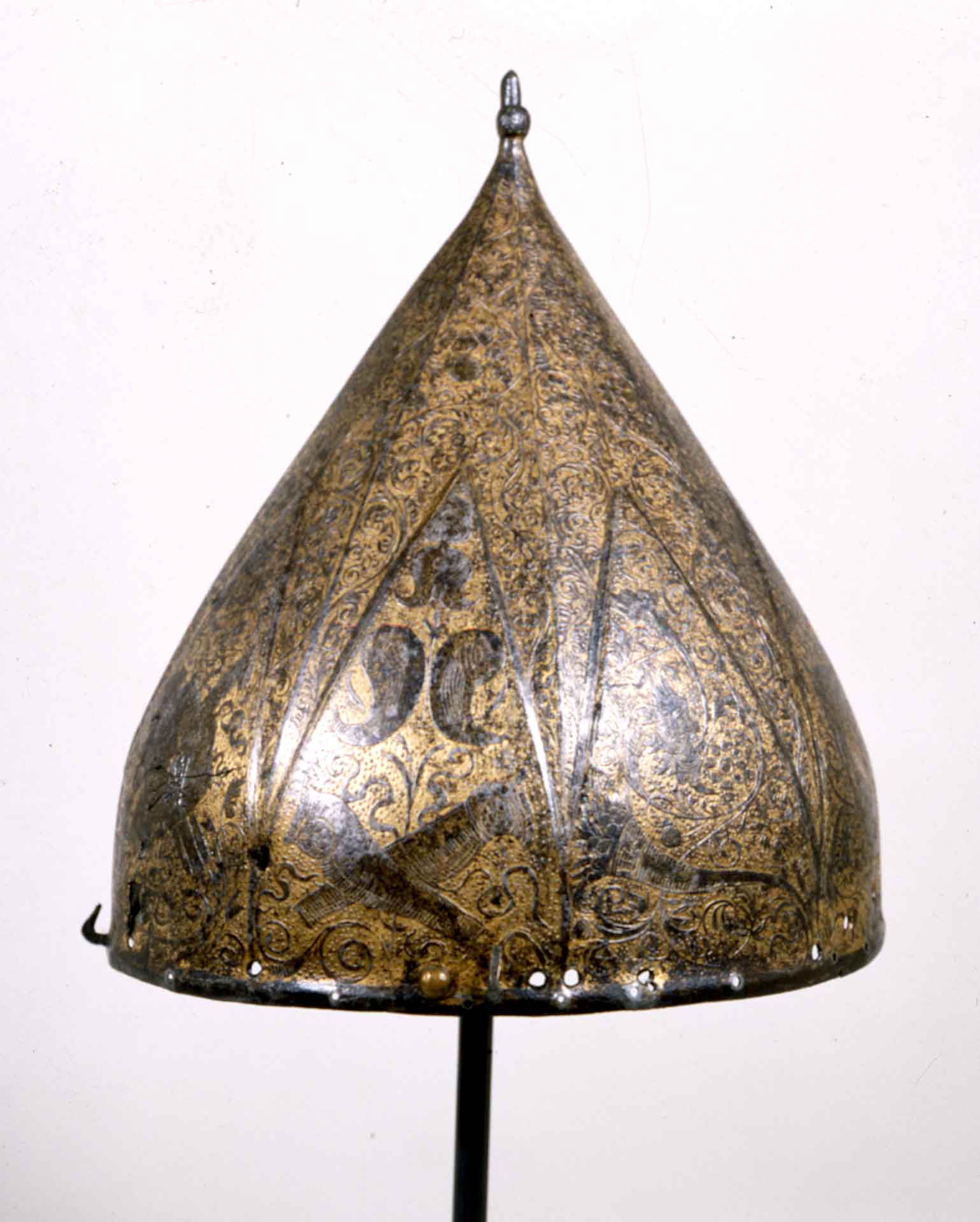
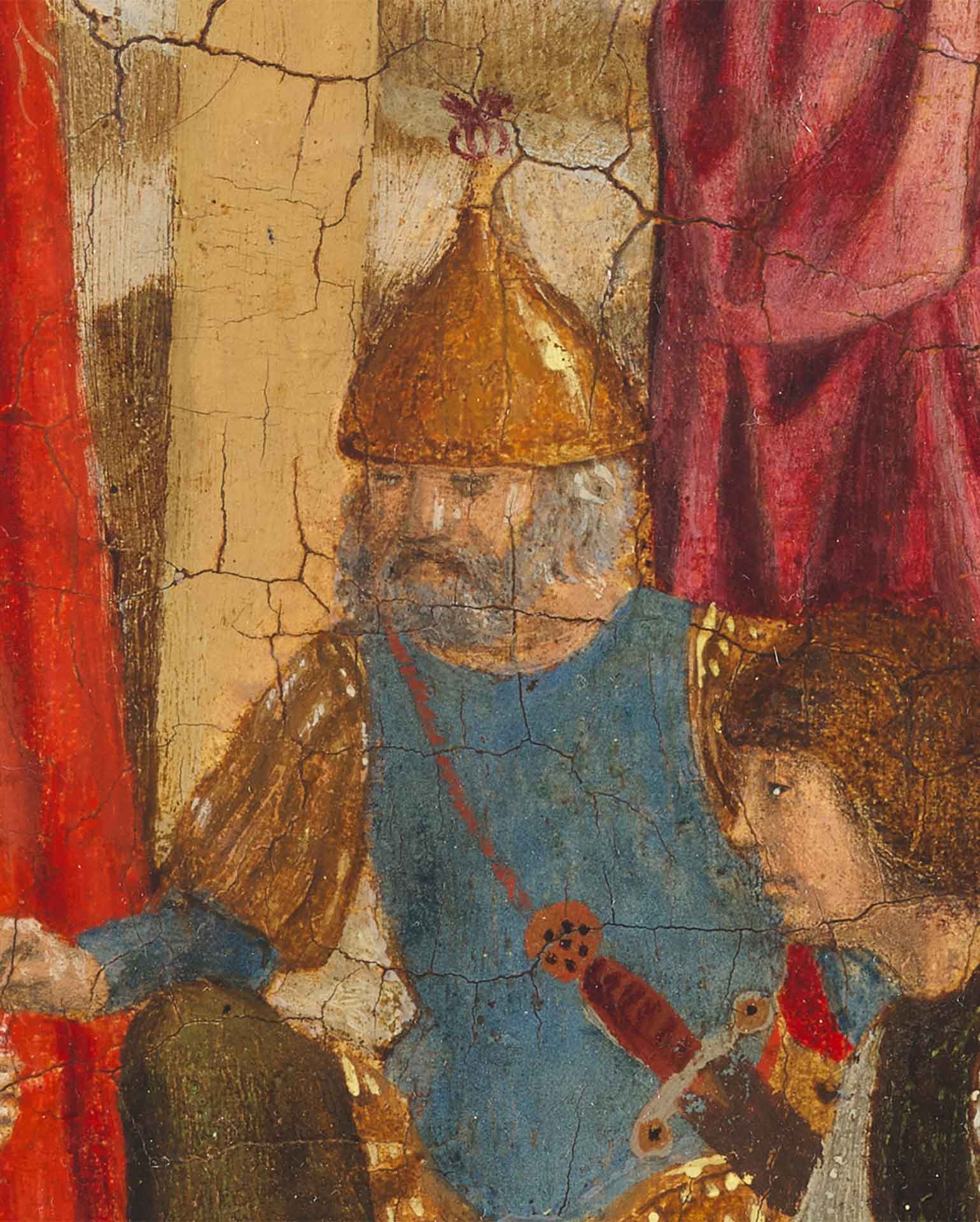
In the Crucifixion, as in his cycle of the Legend of the True Cross in Arezzo, Piero painted groups of Roman soldiers, in an imaginary reconstruction of how they would have appeared in the time of Christ and in the exotic location of the Holy Land. The soldier seated at the foot of the cross wears a pointed helmet with a small crest on top. The type had been widespread in Asia in the thirteenth century.
Piero may have observed such helmets in 1438–39, when Emperor John VIII Palaeologus and his entourage visited Ferrara and Florence for the Church Council. Witnesses to the event believed that the Byzantines wore headgear that had been unaltered since early Christian antiquity. He could also have seen such helmets in Italian armories where they were presented as war trophies.
The type had an impact on armor produced in the West and would remain in use until the seventeenth century. This helmet dates from about 1550–70 and was made in Nuremberg for the Islamic market.
2.
Falchions, or “Storte”
(inv. 1788 and 1791) Venice (?), c. 1620
Wrought steel and iron wire
ArmORY, vetrina 3
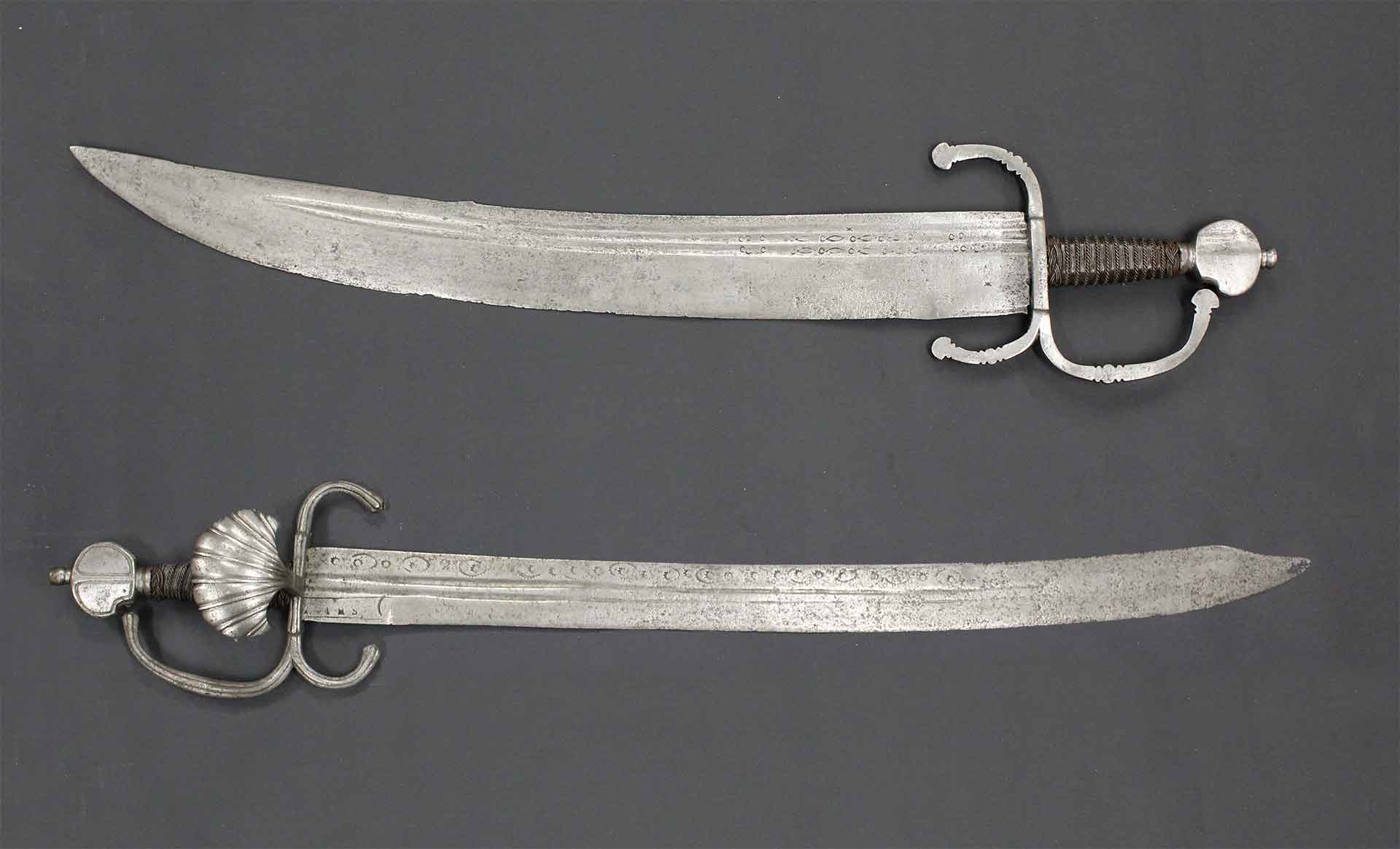
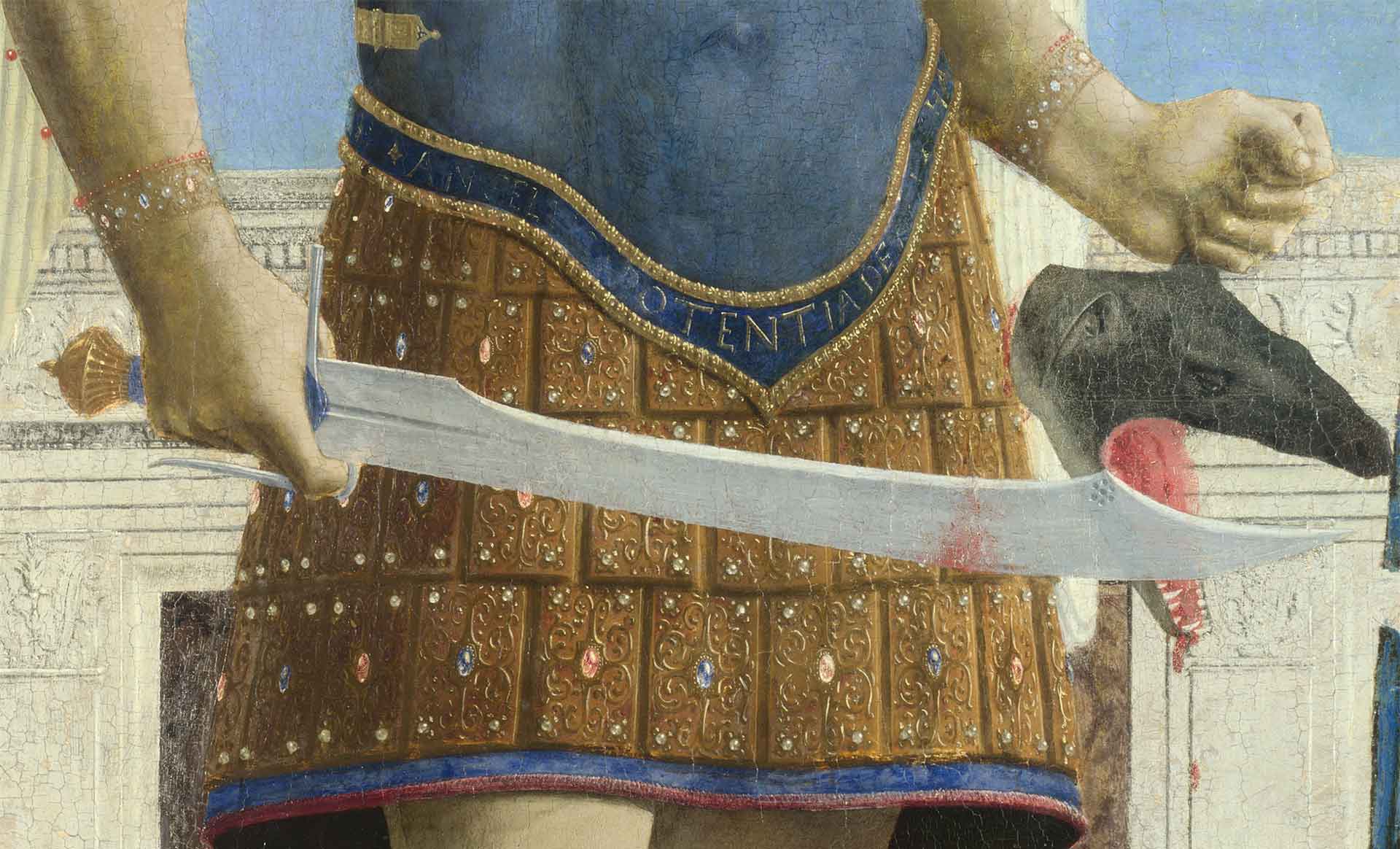
The sword wielded by Saint Michael, is called a falchion, or storta (meaning “crooked” in Italian) because of the curvature of its blade. Two very similar falchions are preserved at the Poldi Pezzoli Museum. This type of sword was used extensively by late-medieval European infantry and was closely related to the falchion and the gisarme. These typologies are reminiscent of antique weapons, such as the Greek kopis and machaira, which through modifications in the Mediterranean Medieval times, became close to the scimitar and made it both an ancient and modern weapon representative of different cultures.
Saint Michael’s falchion, like the swords displayed here, is adorned by a typically fifteenth century pommel, a guard to protect the hand, and even a blue leather or fabric hand grip to match the angel’s anatomical cuirass.
3.
Piero del Pollaiolo
Portrait of a Young Lady (inv. 442)
Tempera and oil (?) on panel
GOLDEN ROOM
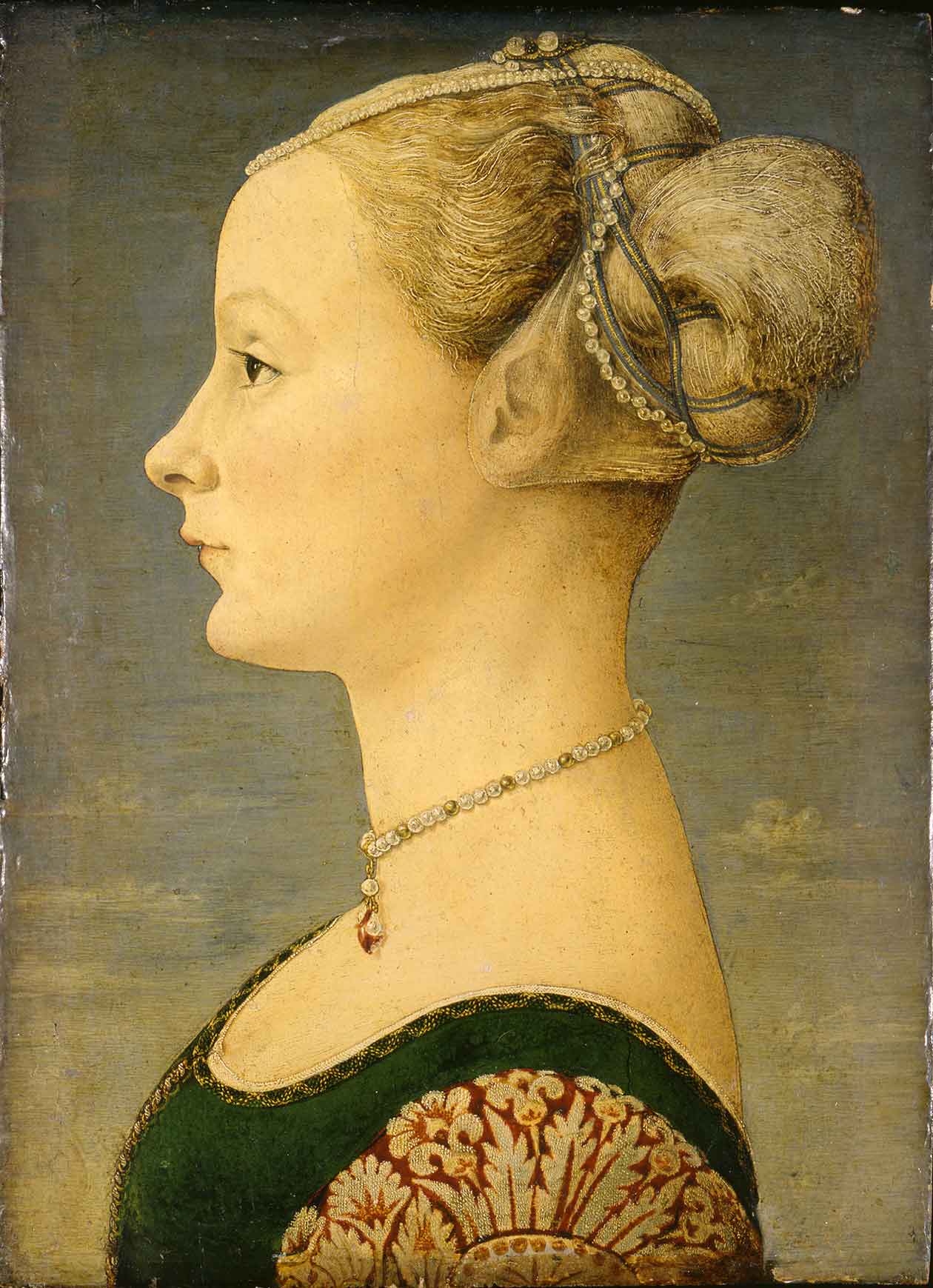
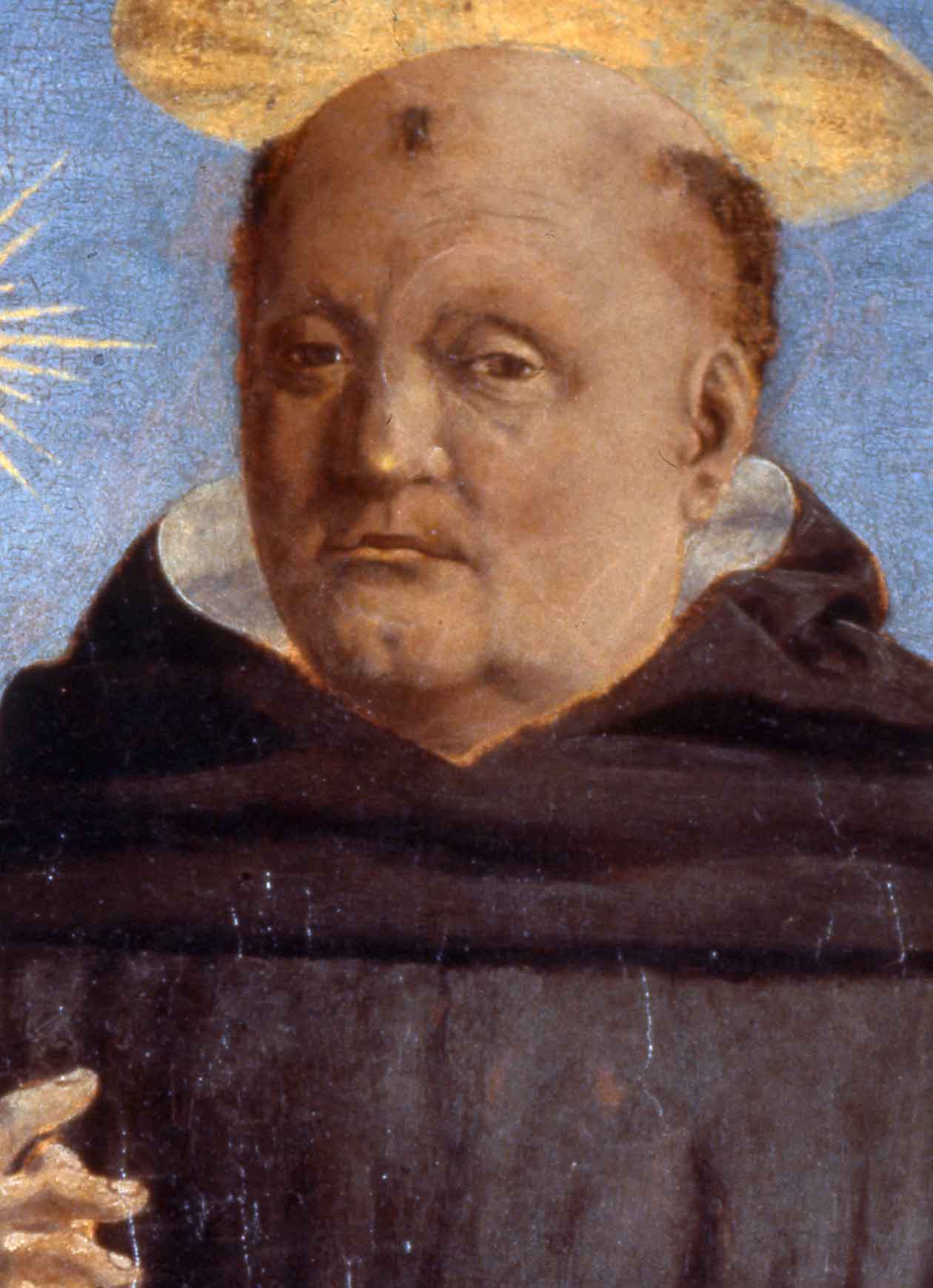
This painting is Poldi Pezzoli Museum’s most iconic artwork. Shortly before 1872, it was purchased by Gian Giacomo Poldi Pezzoli as a work by Piero della Francesca and the attribution remained unchallenged until the early twentieth century. By contrast, when Gian Giacomo Poldi Pezzoli bought the Saint Nicholas of Tolentino, it was thought to be by Fra Carnevale from Urbino (c. 1420/25–84). The art and style of Piero della Francesca came into focus only in the early twentieth century; in 1912 the art historian August Schmarsow attributed the Saint Nicholas to Piero.
4.
Hood of a Cope with The Coronation of the Vergin on a cartoon
by Sandro Botticelli (inv. 444)
Florence c. 1480
Embroidery: silk, gold, linen
GOLDEN ROOM
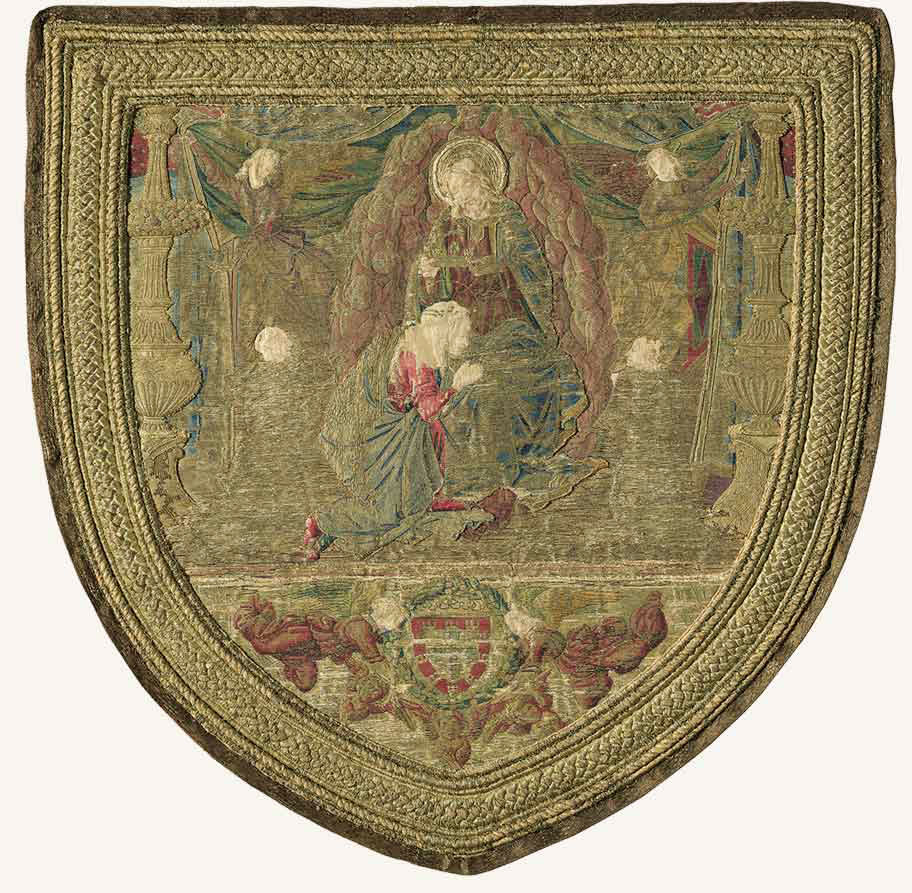
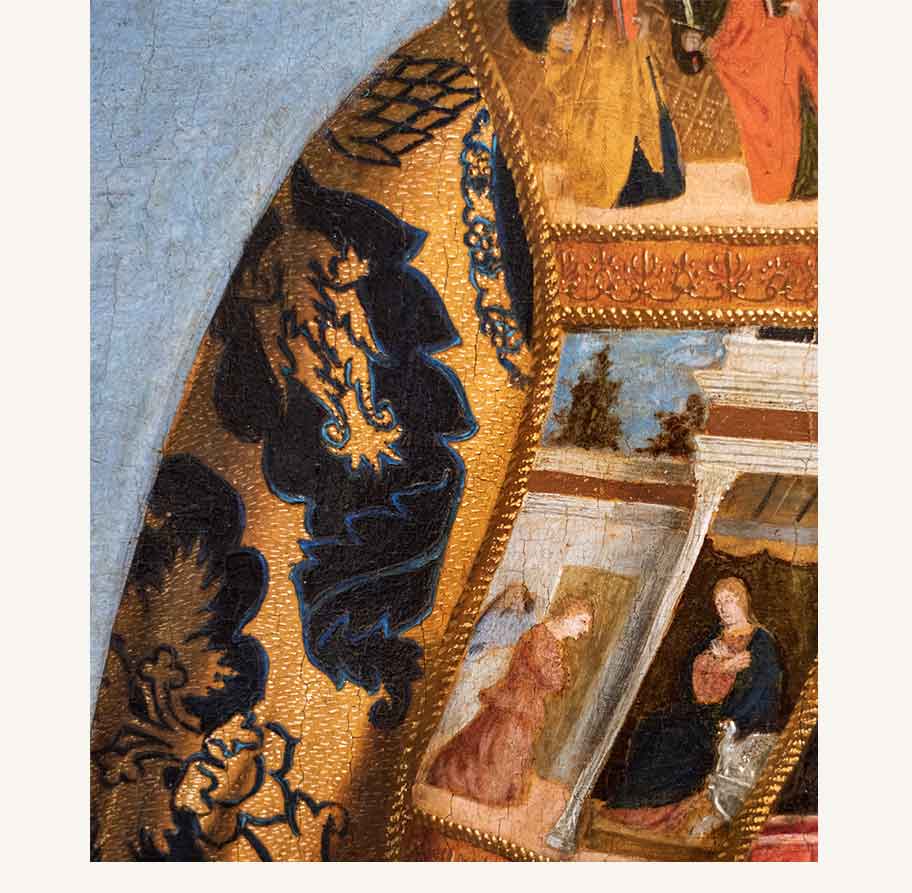
The most luxurious sacred vestments, such as the one worn by St. Augustine, were embellished with embroidery by skilled artisans. They used the or nué technique, in which horizontally stretched gold threads (made of thin strips of gold wrapped around a silk core) forming an underlying weft are couched with colored silk yarns.
In exceptional cases, the design was entrusted to great artists. Sandro Botticelli provided the drawing for this Coronation of the Virgin, which was revealed below the embroidery during restoration. It is a pen-and-ink drawing, transferred to silk by means of a perforated cartoon that has been pounced with charcoal powder, a technique called spolvero also used by Piero in the Augustinian Polyptych.
5.
Anatomical Armor (inv. 2424)
Apulia, 4th century before Christ Bronze
Franzini ROOM
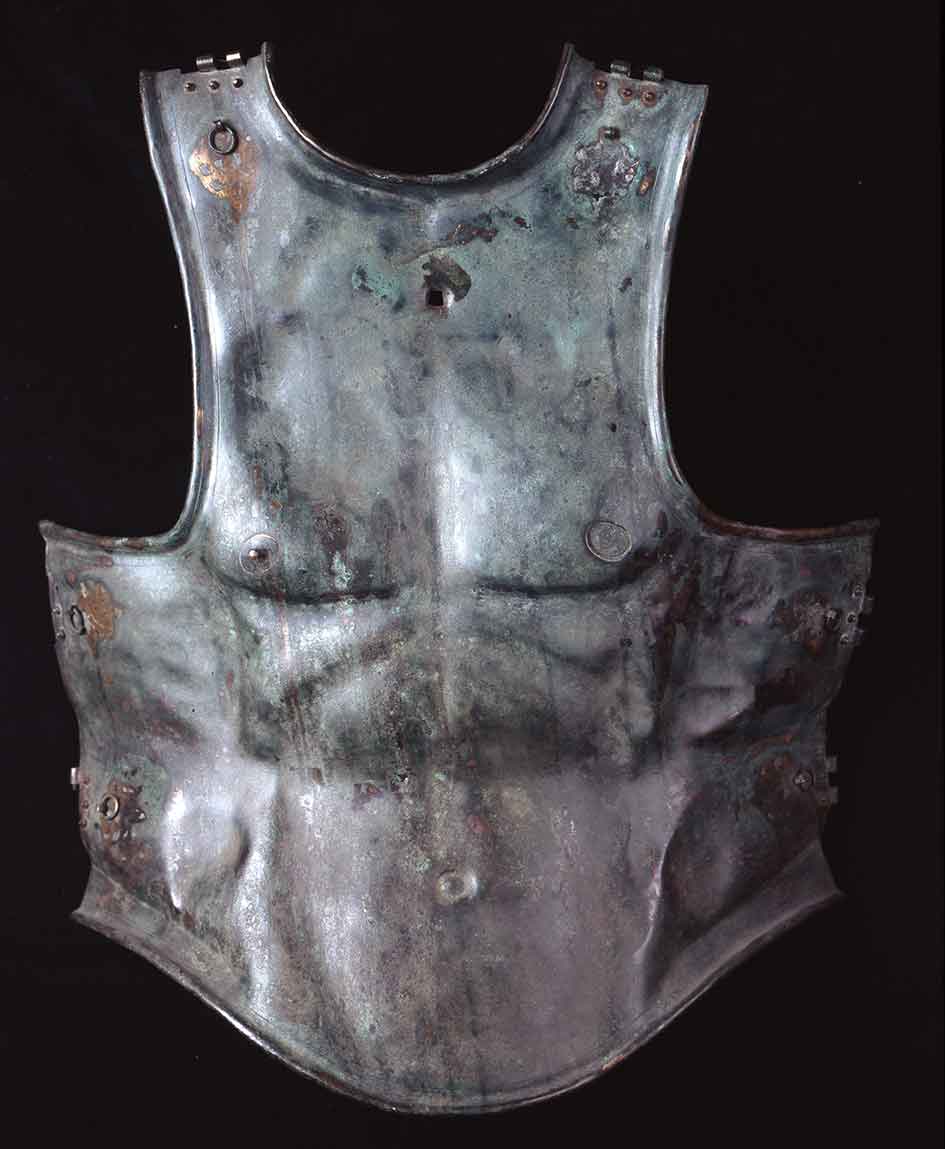
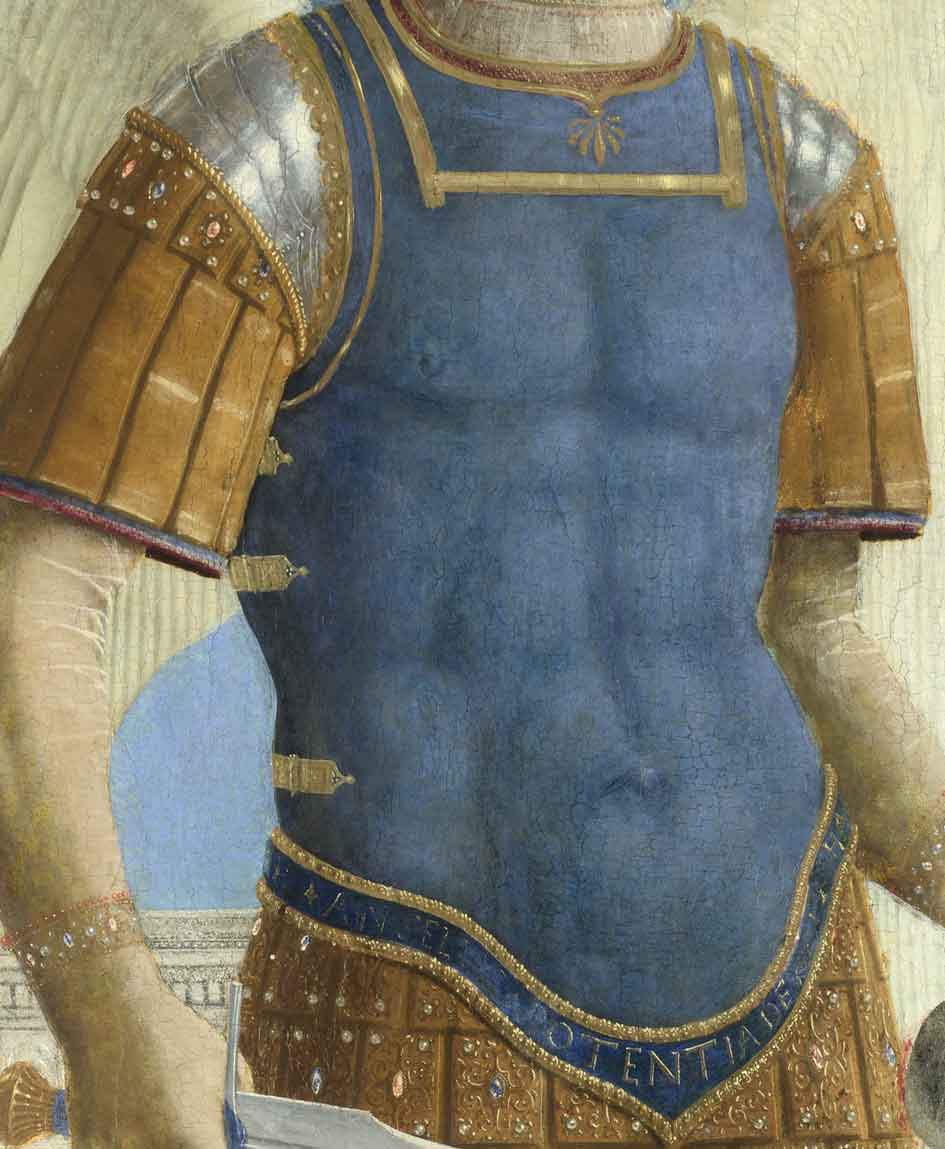
Piero depicted both the Roman soldier at the foot of the cross in the Crucifixion and Saint Michael wearing an anatomical cuirass that distinguished the higher ranks of the Roman army; in Piero’s time such protection was still worn by Byzantine soldiers.
This is a very rare surviving cuirass, probably made in Apulia and dating as far back as the fourth century before Christ. It was probably modeled by hammering a bronze sheet and still retains on the shoulders and sides the hinges and a movable loop for fastening it.
Saint Michael’s cuirass is made of cuir bouilli dyed blue, reinforced with metal elements to protect the shoulders, and leather strips for arm and leg protection embellished with pearls and precious stones. Because of its refinement, it is more suitable for a spiritual triumph than for earthly combat, like this bronze armor.
6.
Morse of a cope (inv. 556)
Siena (?), 14th century
Gilded Copper, enamels
JEWELLERY ROOM
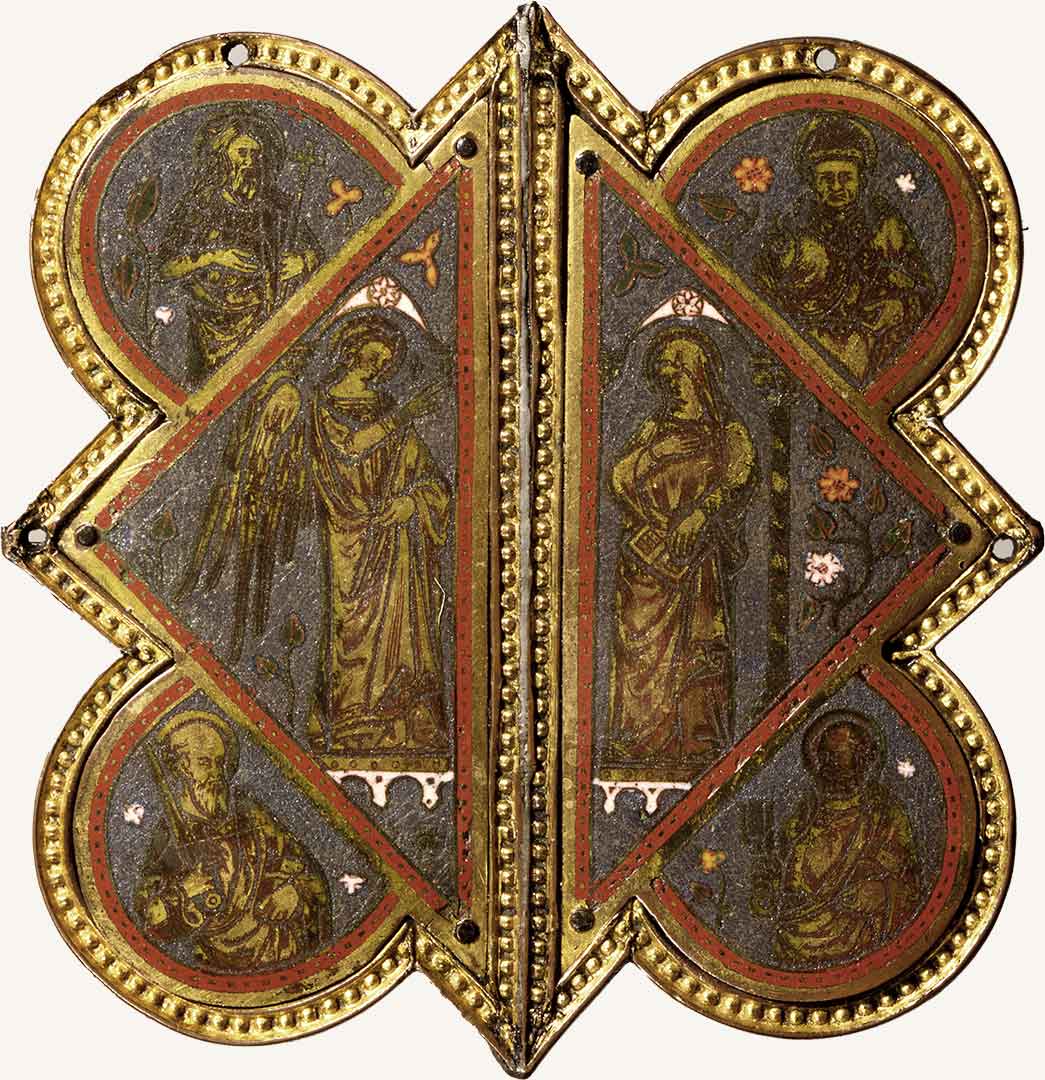
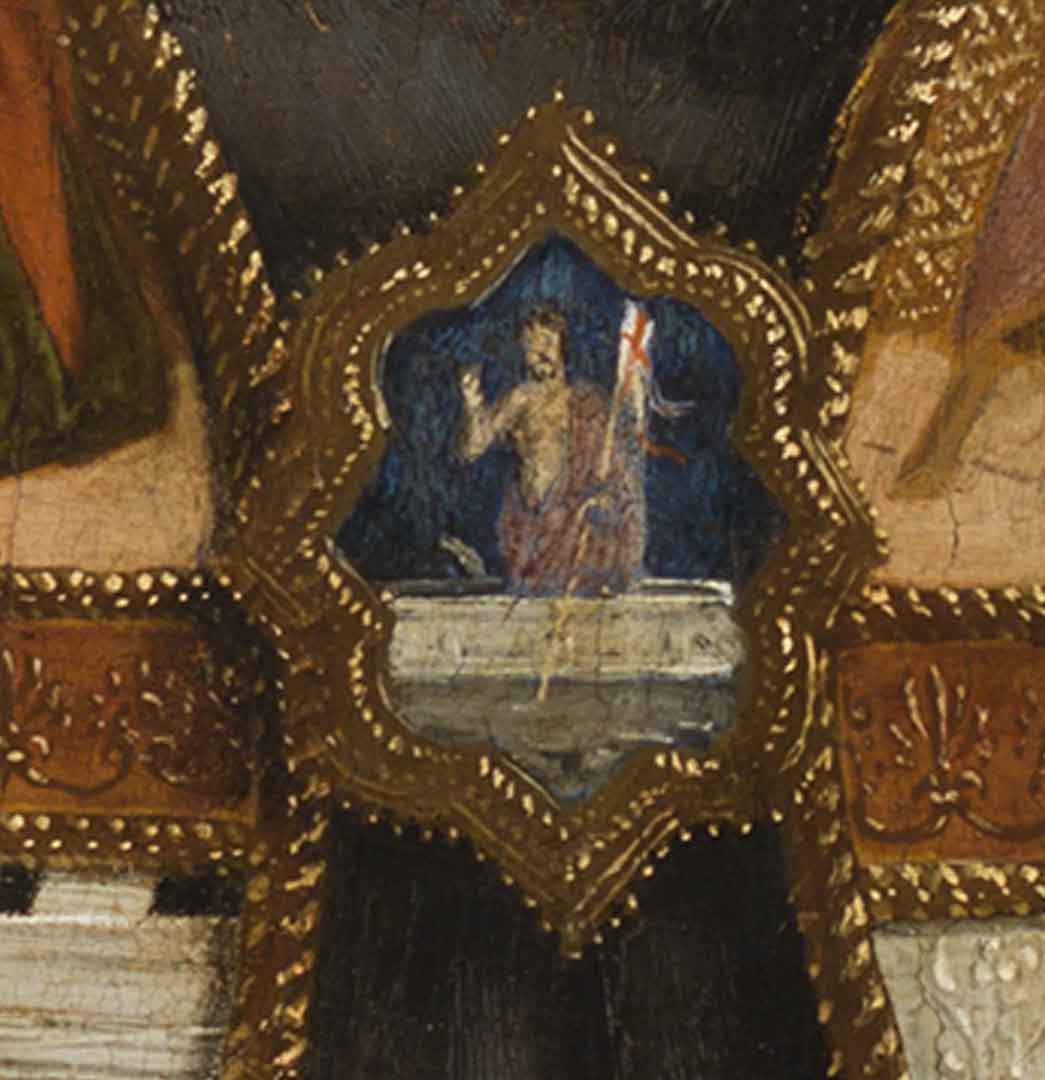
Saint Augustine’s cope is closed by a gold and enamel morse depicting Christ emerging from the tomb against a deep blue background. This is very similar to the goldsmithing of the period, as this fourth-century object shows. In both cases the morse has the shape of a four-lobed rhomboid surrounded by a band of small spheres. In the morse of the Poldi Pezzoli Museum, the gilt figures stand out against a dark blue and depict the Angel and Virgin of the Annunciation. For stylistic reasons it is believed to have been made in Siena in the first half of the fourteenth century.
7.
Altar Crucifix (inv. 523)
Milan, 1511
Gilt silver, silver, rock crystal, and rubies
JEWELLERY ROOM
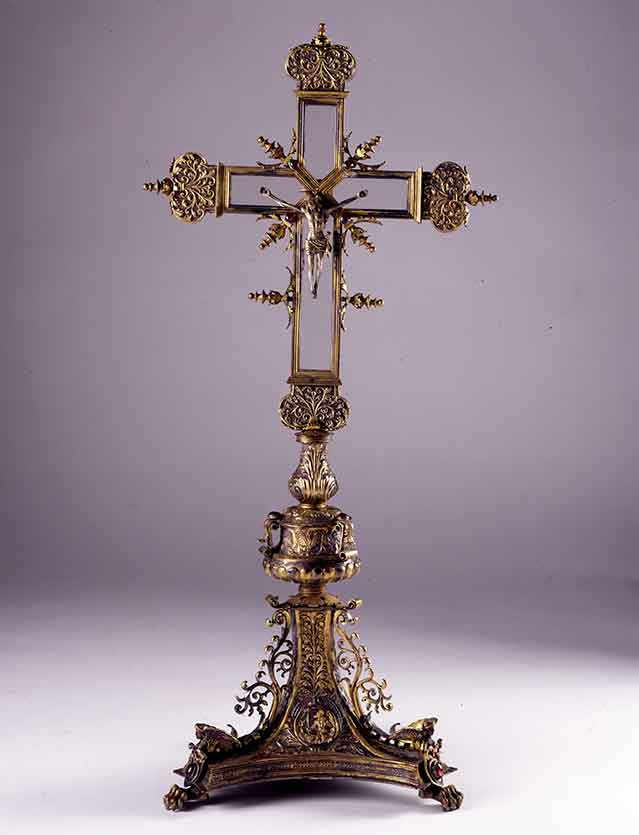
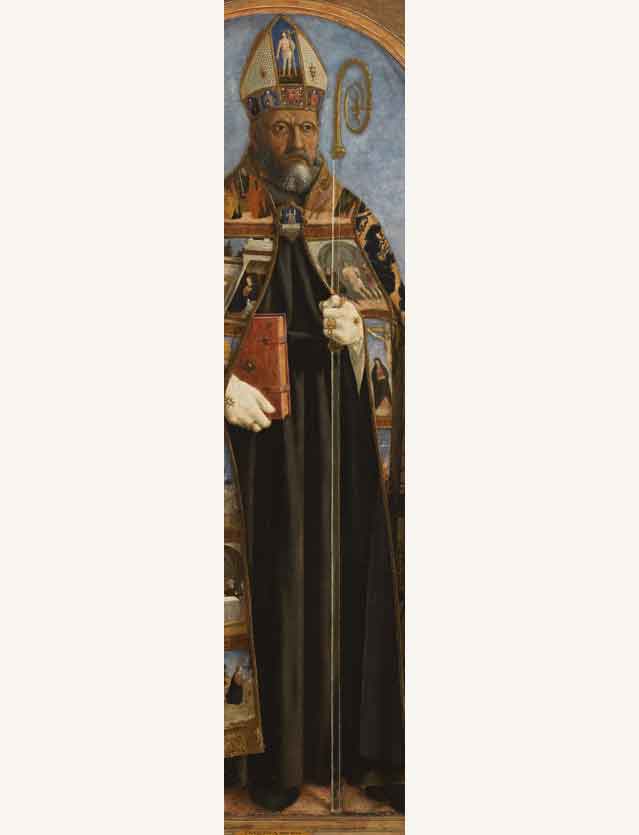
The crozier held by Saint Augustine is made of gold and rock crystal, a precious material that was much used in liturgical objects. It is a colorless variant of quartz and its name comes from the Greek kruos, ice. Because of its ethereal appearance it is a symbol of purity. In this cross you can admire the transparency of the material. The shaft of Piero’s crozier is of an improbable length, not only because of the fragility of the rock crystal, but also because of the limited size of the stone’s formations found in nature.
8.
Ring (inv. 647)
Italy, 14th century
Gold, enamel, and rock crystal
Ring (inv. 660)
France (?), late 15th century
Gold and rock crystal
JEWELLERY ROOM
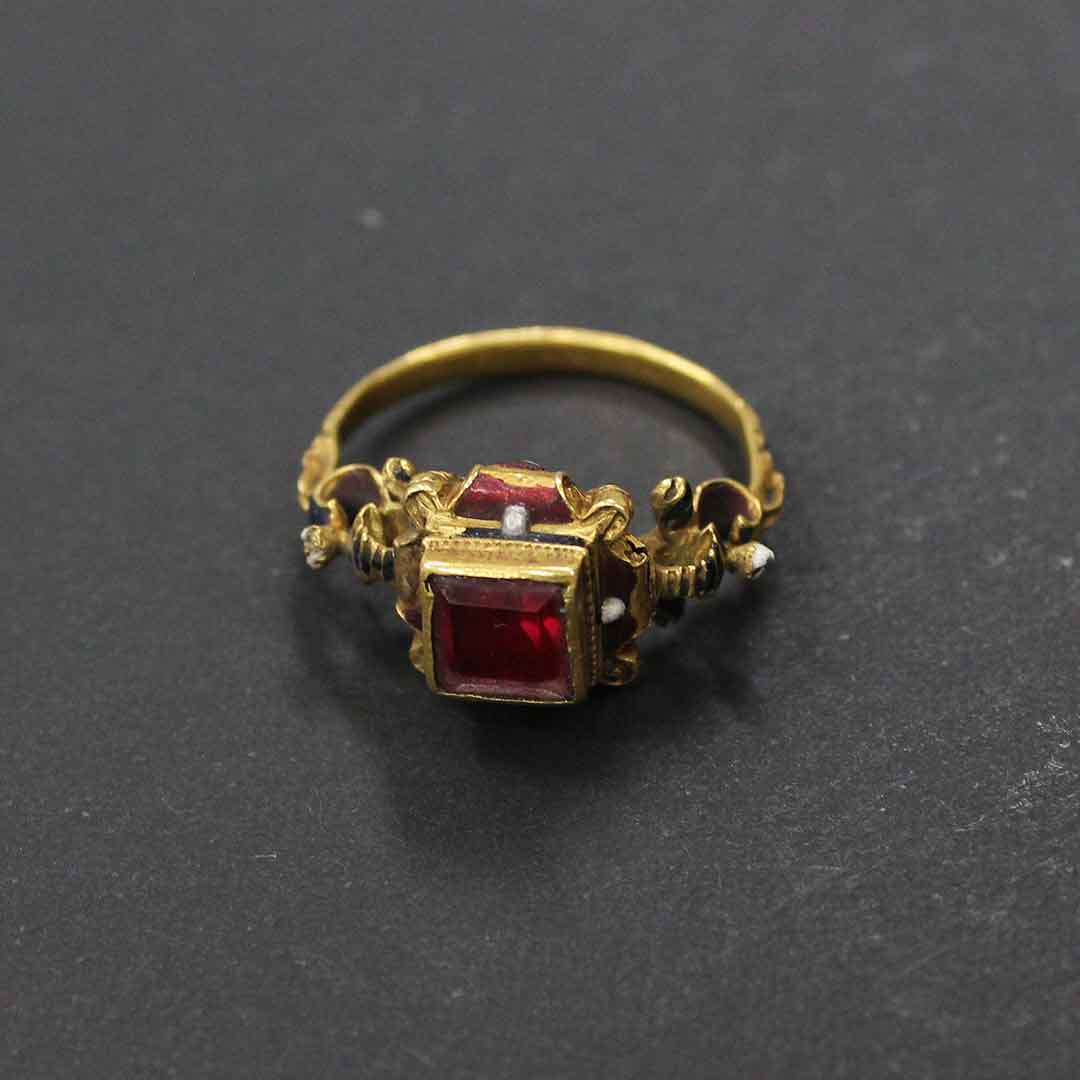
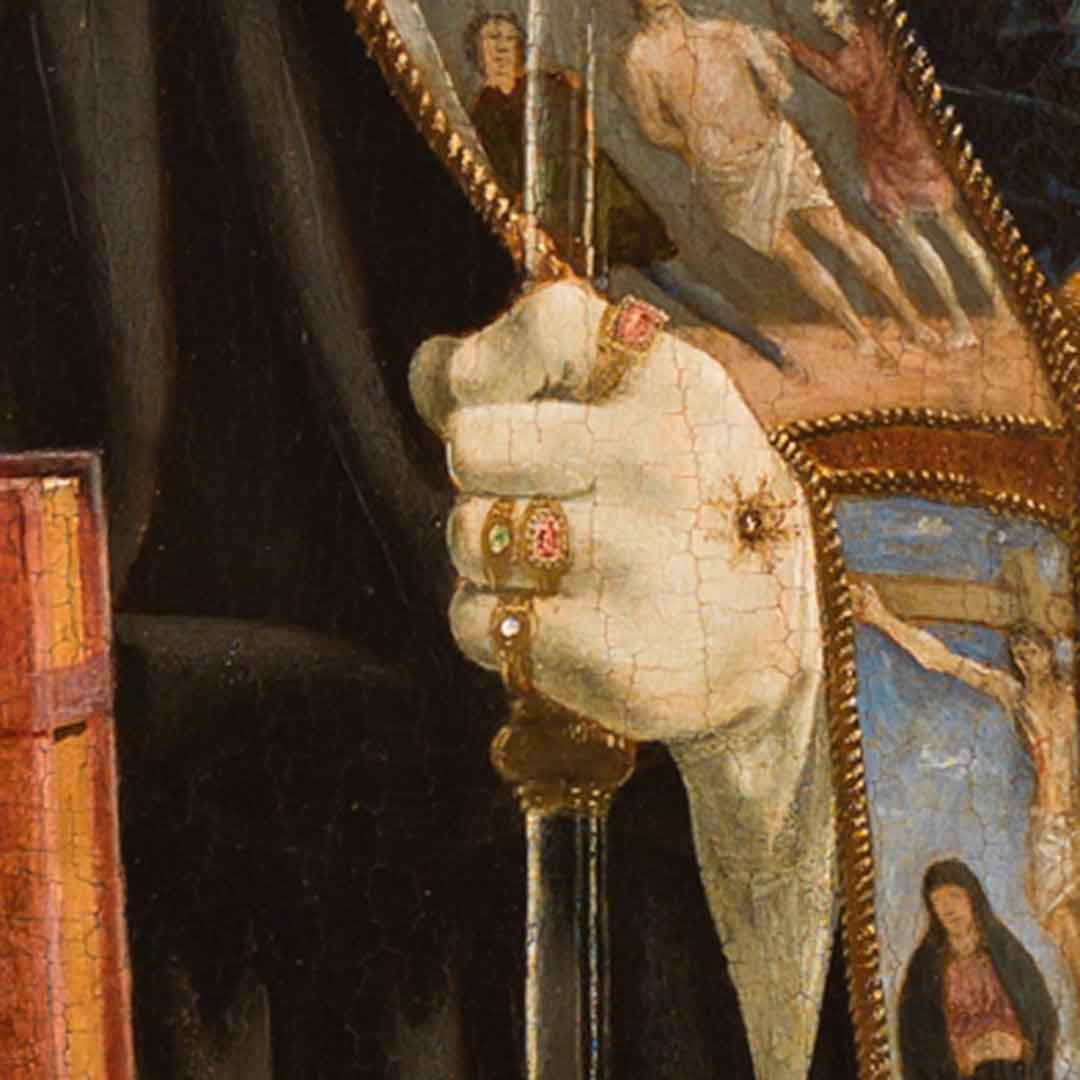
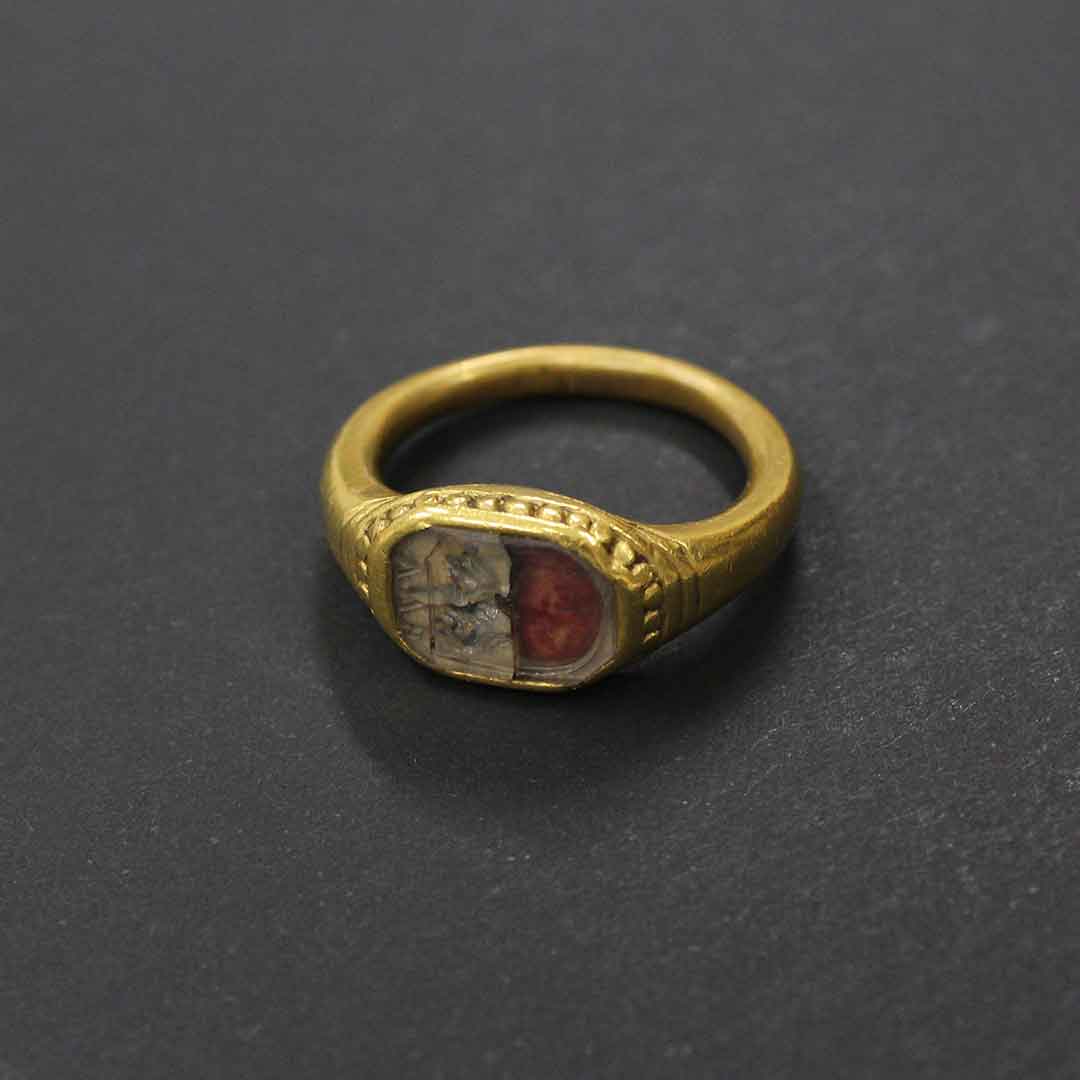
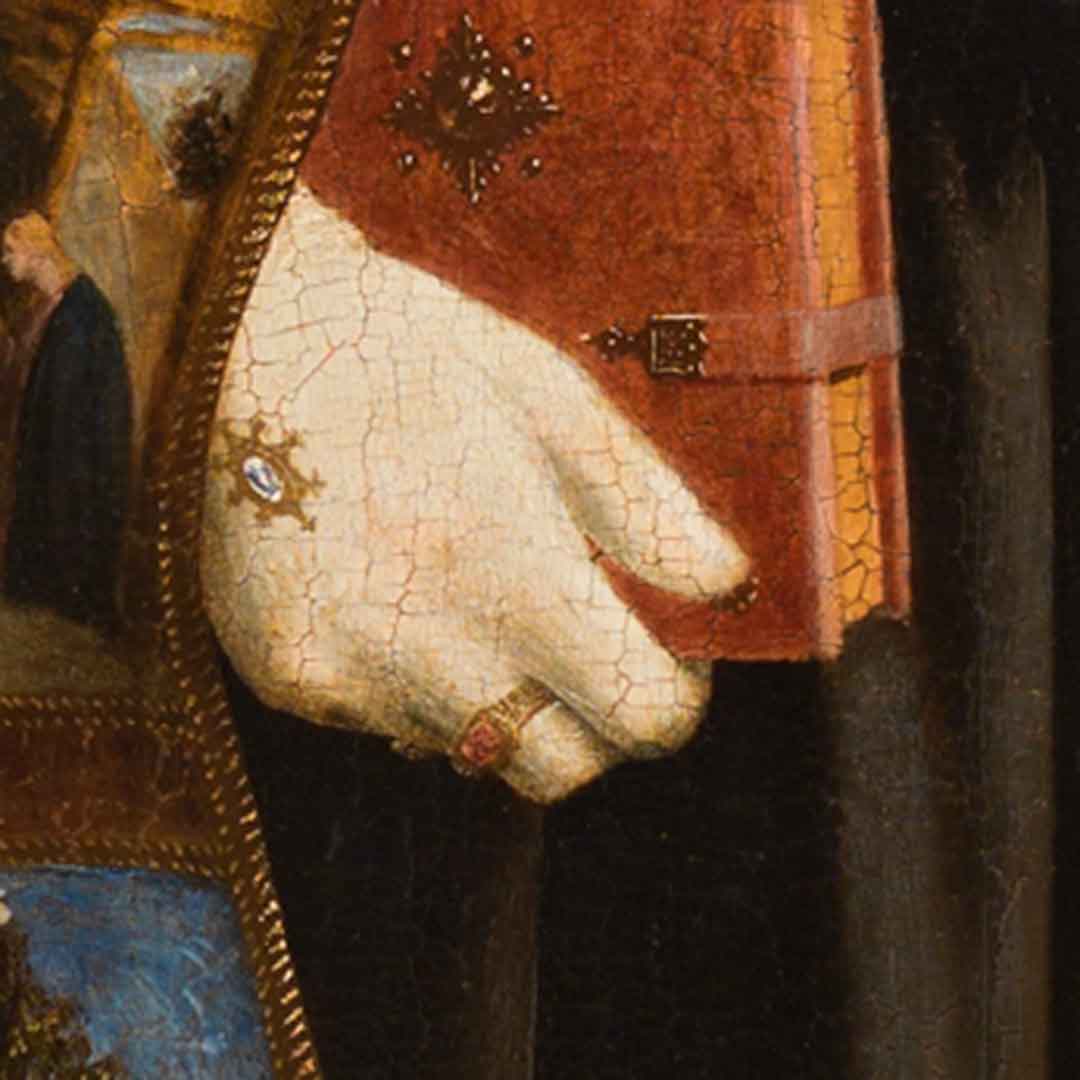
To emphasize his role as prince of the Church, Saint Augustine wears rings of gold set with precious stones over his silk gloves. Now observe the rings set with a ruby in the center of the third row: they date from the fifteenth and sixteenth centuries and therefore reveal Piero’s absolute fidelity in rendering the style of goldsmithing of his own time.
9.
Girdle (inv. 573)
Lombardy, late 15th century
Silver, gilt silver, fabric with silver threads
JEWELLERY ROOM
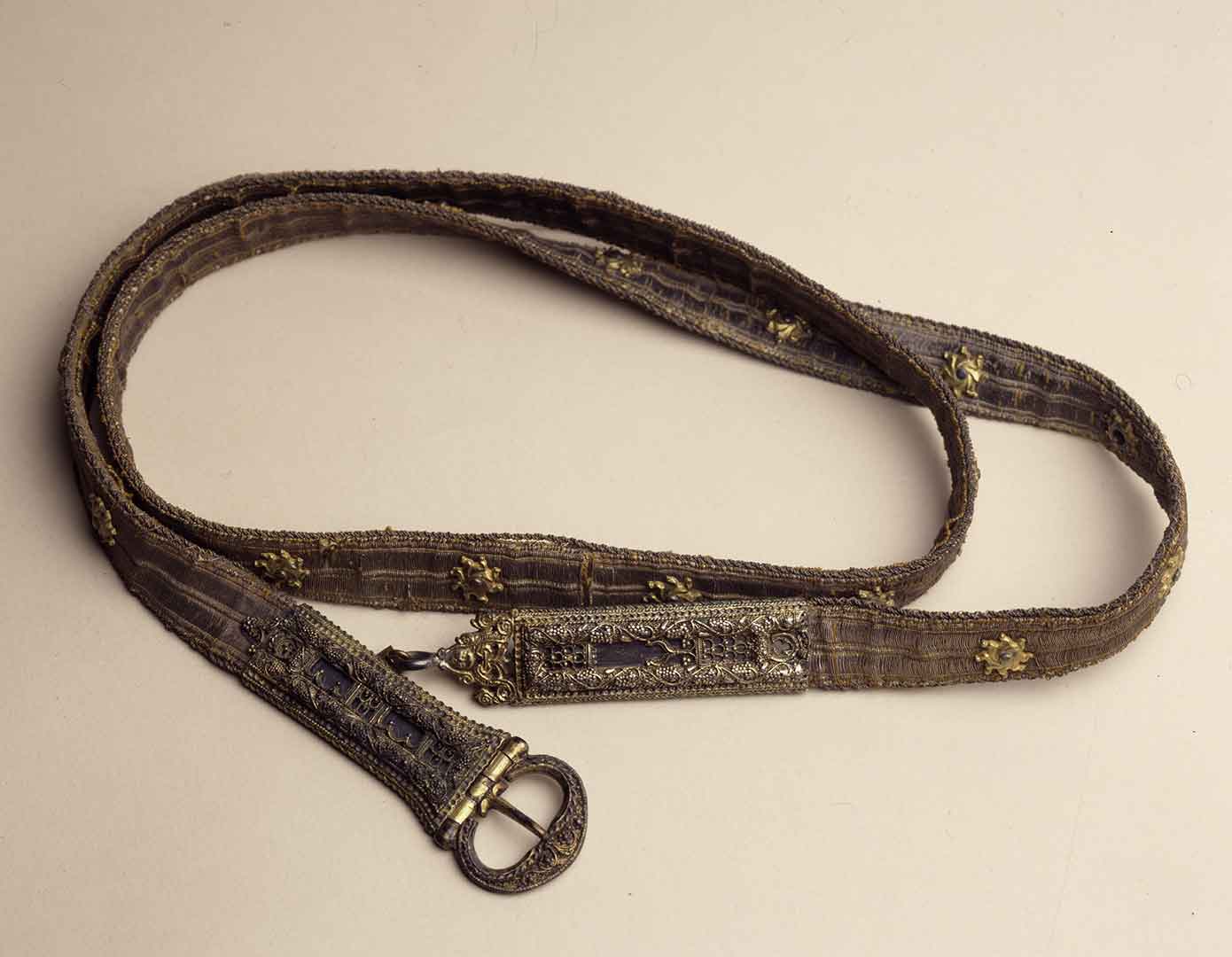
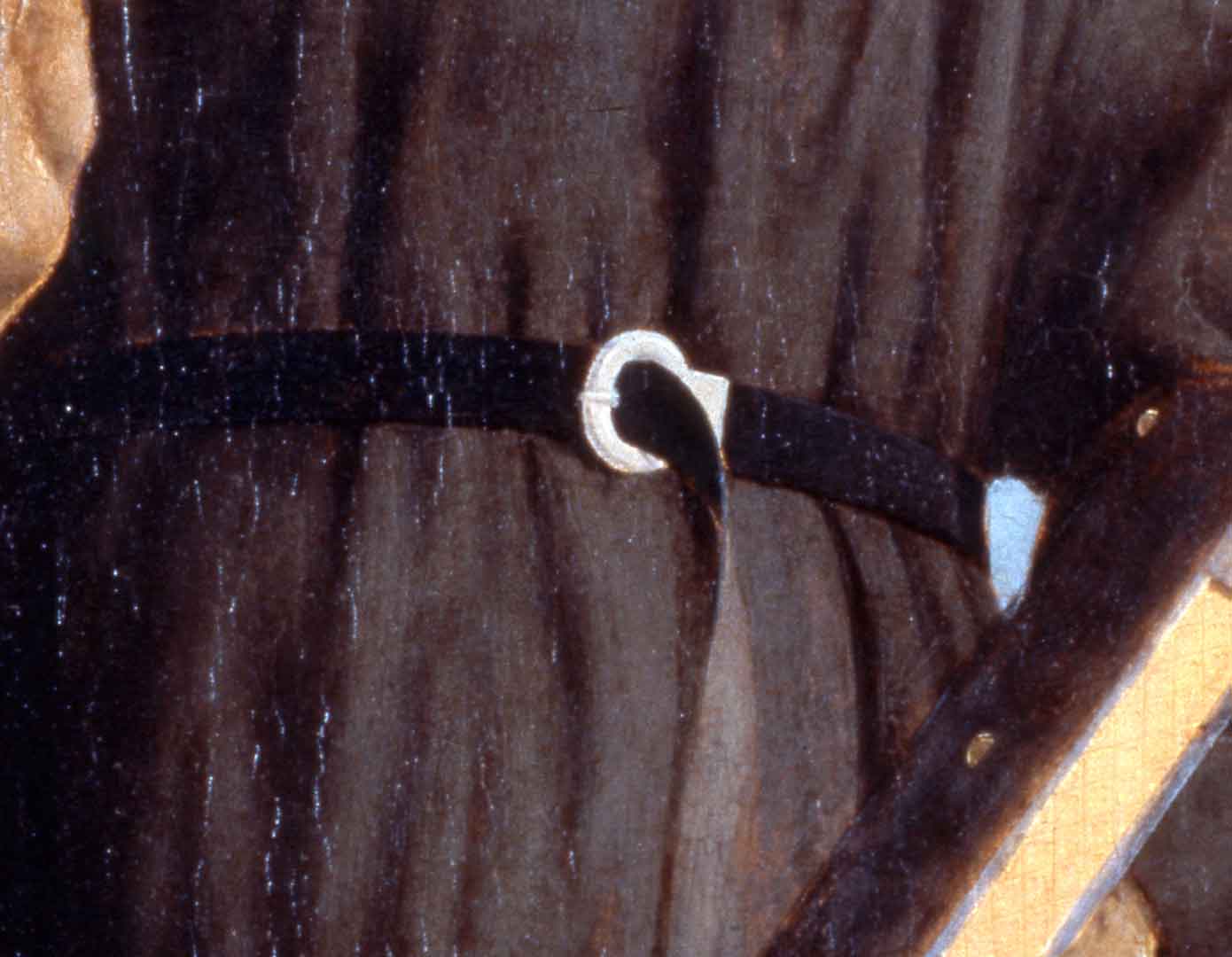
This girdle of a lady, made of fabric with silver threads and embellished with twenty-two gilt silver fittings in the shape of radiating stars, dates from the last quarter of the fifteenth century and was therefore made at the time in which Piero painted the belt of Saint Nicholas of Tolentino.
The outline of the buckle is almost identical to that of the saint’s belt. The Marchigian friar’s belt is as simple as is the girdle is rich in sumptuous detail. It probably belonged to an aristocratic lady from Lombardy.
10.
Fragments of fabric (inv. 3363 and 3191)
Italy, late 15th century
Silk and foliated silver; cut velvet, lustred, worked to a body with thrown wefts
Part of a Chasuble (inv. 235)
Italy or Spain, 1550-1600
Silk, silver and gilded silver; Cut voided velvet, brocaded with gold with effects of metal weft loops
Sala del collezionista
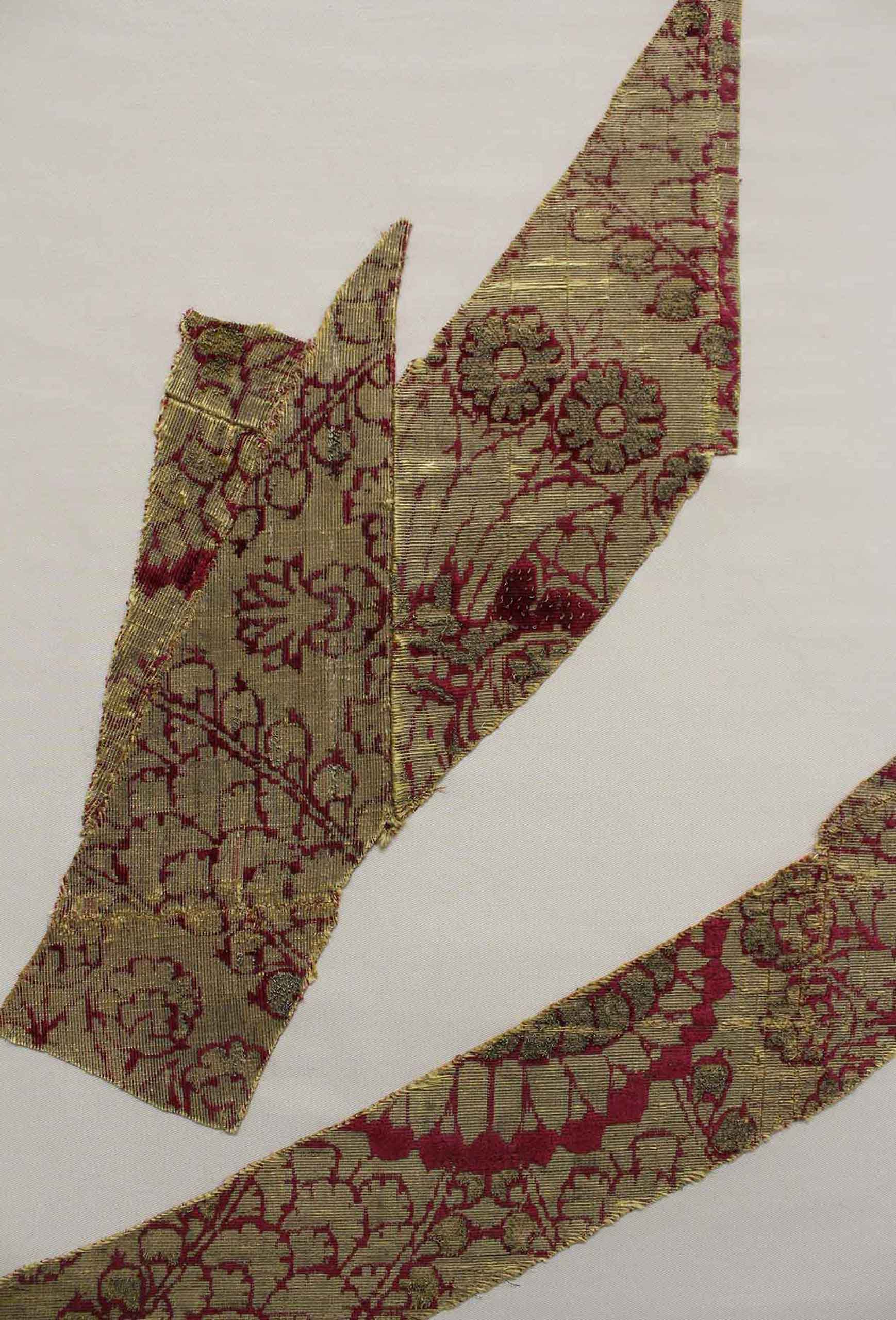
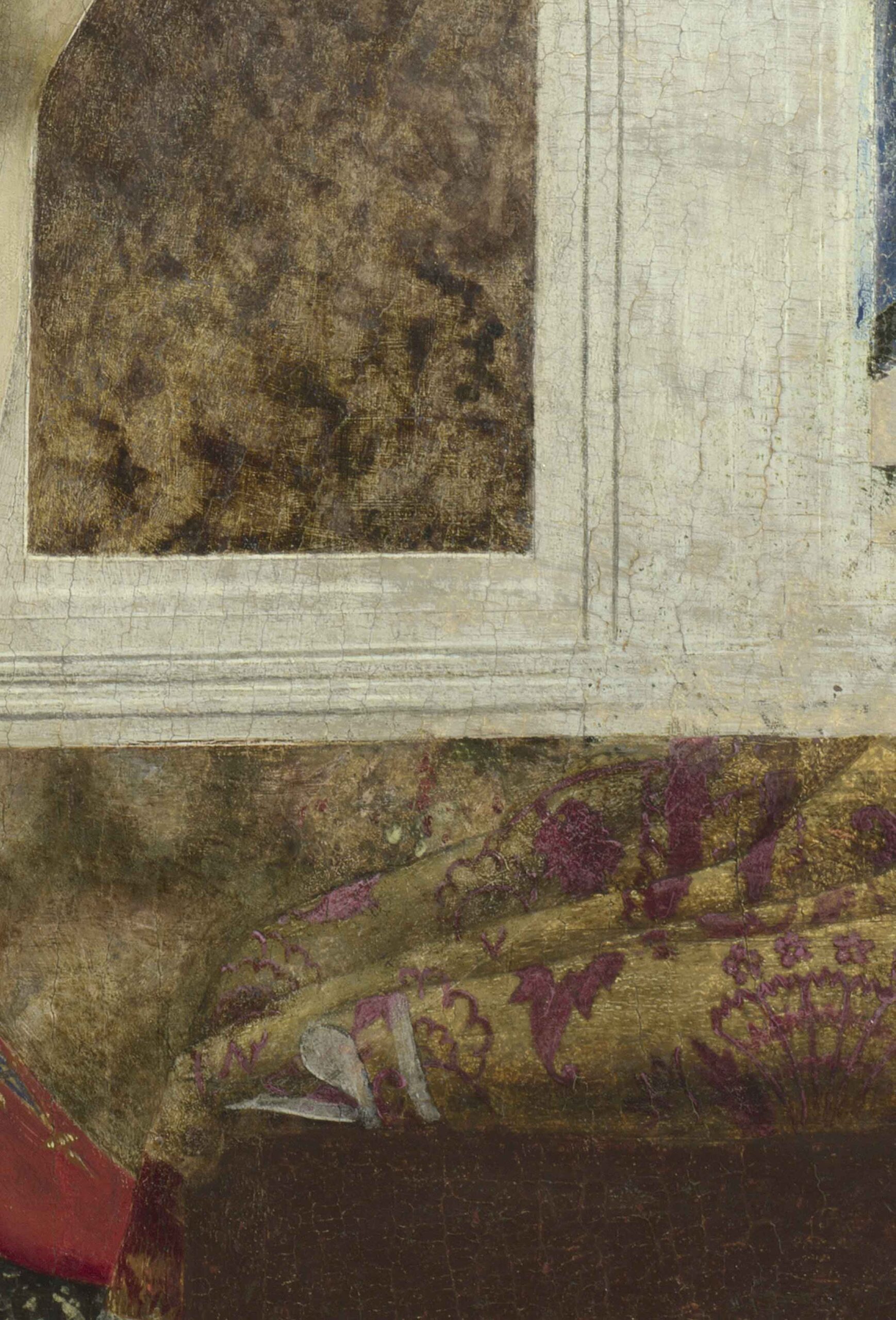
These fragments of velvet have the same thistle and pomegranate decoration as the robe of the Virgin that Piero della Francesca painted at the feet of Saint Michael. It is a brocaded velvet made on complex drawlooms. Its full red color was obtained with a fine and expensive crimson dye. The small loops of gold threads give a so-called bouclé effect and when juxtaposed with the silk parts, in some velvets even cut at various heights of pile, give a three-dimensional effect to the fabric, as can also be seen in the brocade of the cope of Saint Augustine painted by Piero. When gold and silver loops are instead found scattered throughout the silk background, shining like fireflies, they produce the “allucciolato” effect (lucioli in Italian meaning fireflies). These fabrics were very precious and were used for deluxe clothing and furnishings intended for special occasions, as you can see in the court scene in the tapestry behind you.
